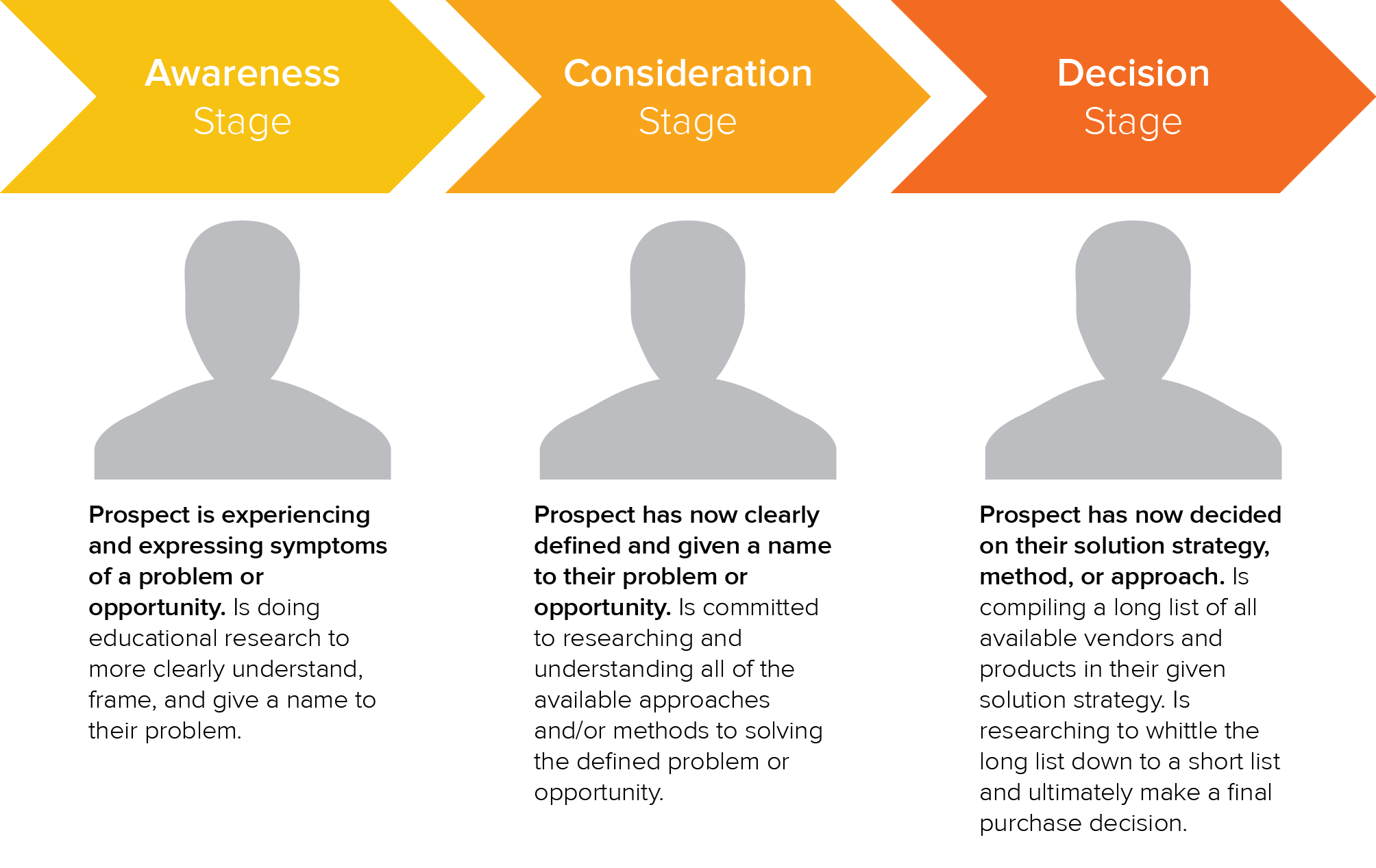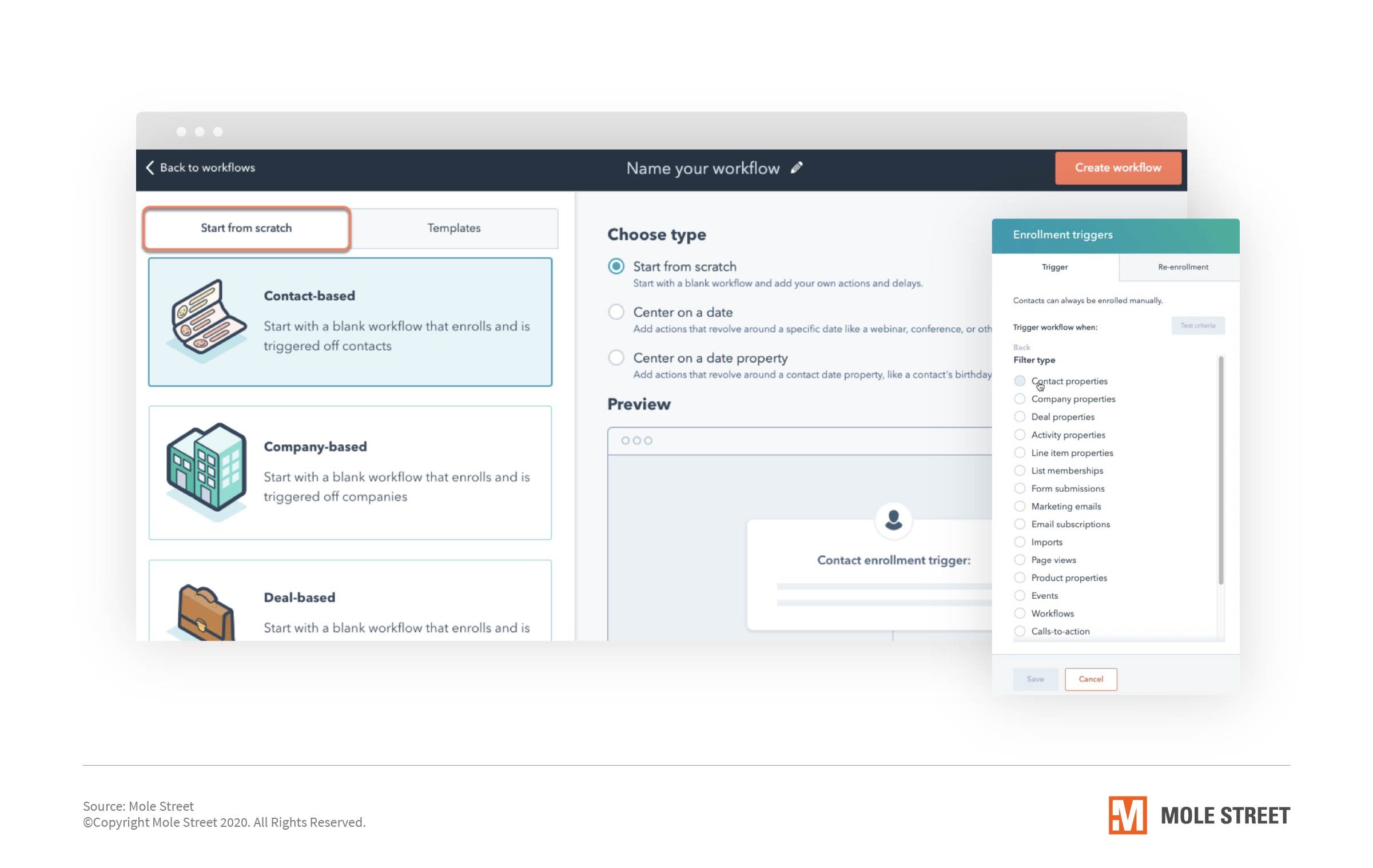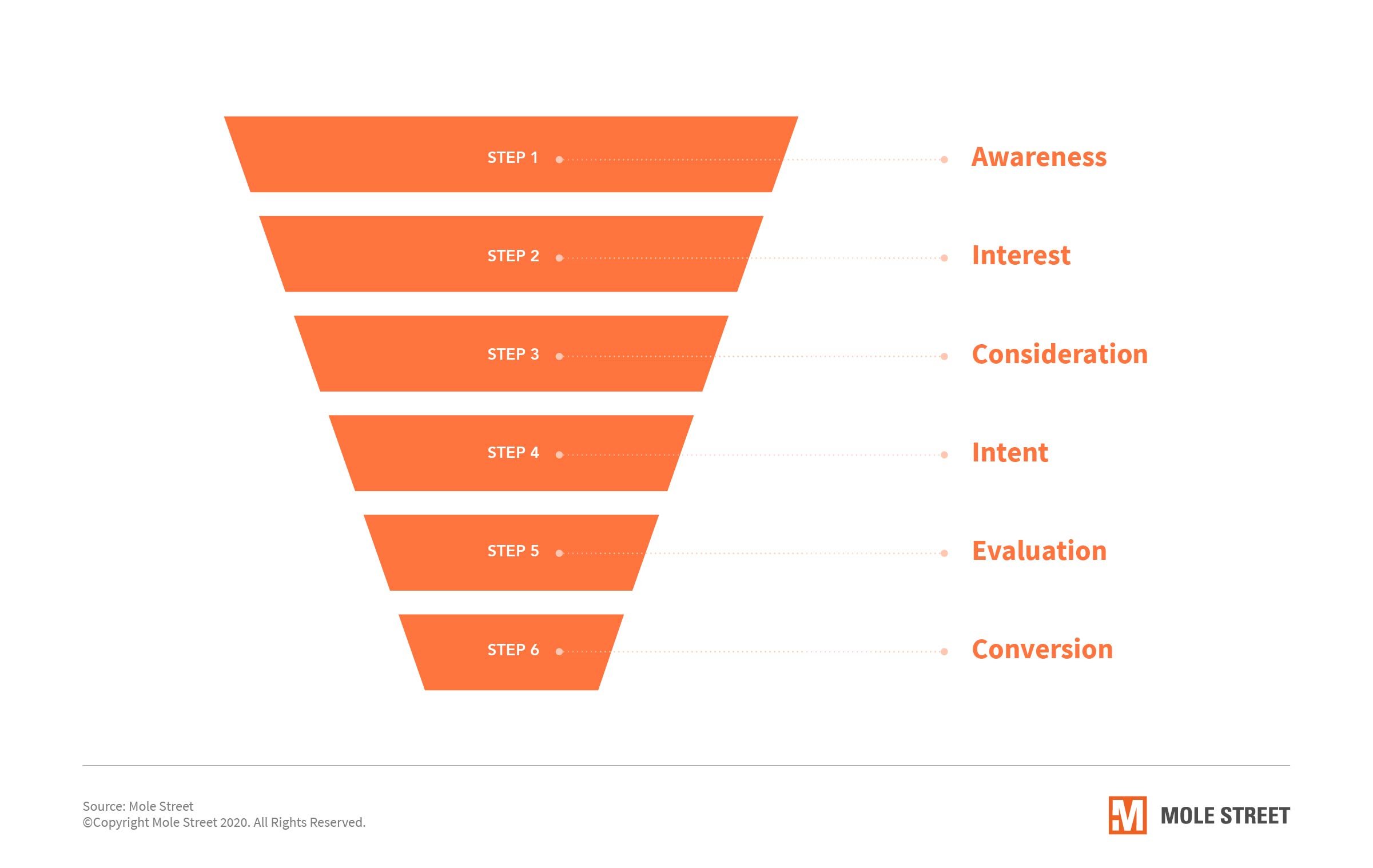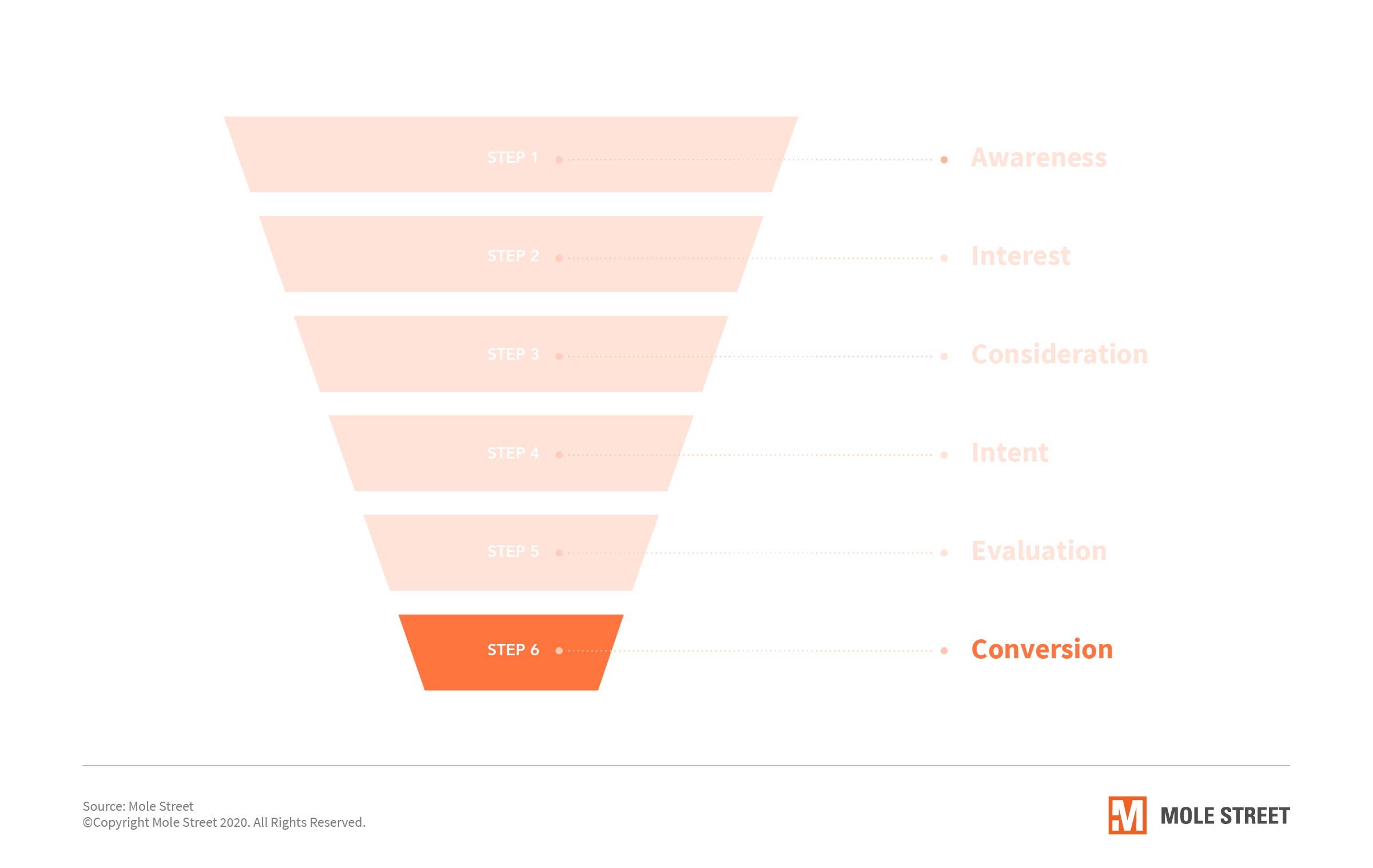HubSpot Workflow Best Practices for Lead Nurturing

The customer journey. The purchase funnel. The buying cycle.
They’re all different terms that refer to the same idea. Every organization needs an established purchase funnel, along with a steadfast commitment to consistently analyzing and improving that funnel. Otherwise, the risk for losing prospects on their journey to becoming customers increases each step of the way.
In this post, we’ll define the purchase funnel, walk through the steps of the funnel, and explain how to utilize marketing automation software to improve your conversion rates throughout the sales cycle with the help of workflows.
What is the Buyer's Journey Funnel?
The buyer's journey funnel is the phased approach a person takes as they transition from being a stranger to your business to becoming a customer. As time passes and contacts interact with your marketing and sales materials, these prospects move through the funnel toward either becoming customers or dropping out of the funnel altogether.

Image courtesy of HubSpot
HubSpot workflows in the customer journey
Sales & marketing automation software HubSpot has a workflows feature that automates the steps needed to move more contacts through the buyer’s journey. Once contacts are enrolled in a workflow, they will be sent content and messaging based on the next action you want that contact to take. For example, once somebody has downloaded an ebook, a workflow can be triggered to attempt to turn that contact into an MQL through product-related content and invitations to speak to the sales team.
If you’re a HubSpot customer, follow these steps to set up your workflows – we’ll go through the process of how to employ workflows to move contacts into each stage of the purchase funnel a little later on. You can also read about the most up-to-date ways of building HubSpot workflows here.

- Once you’ve logged into HubSpot, go to “Automation,” then “Workflows.”
- Click “Create Workflow.”
- Choose your workflow type. You can choose one of the following:
- Start from Scratch: build a contact-based, company-based, deal-based, or ticket-based workflow. For the purposes of lead nurturing, we suggest contact-based workflows.
- Templates: build a workflow based on a pre-set group of enrollment triggers and actions. For the purposes of lead nurturing, you’ll want to use “Set a Lifecycle Stage to MQL,” although if you go down this route, you’ll need to make other workflows in the Start from Scratch path.
- Name your workflow, then click “Create Workflow.”
- Click “Set Enrollment Triggers” to determine the action a contact must take to enroll in your workflow.
- Under “Filter Type,” choose the criteria that you want to filter contacts and initiate actions by. Examples include “Lifecycle stage is lead” or “Contact has filled out any form on [name of ebook] landing page.”
- Add actions to continue the workflow, such as a time delay, enrollment in a separate workflow, or an if/then branch – which creates two separate paths within the same workflow to send different types of contacts along paths more fitting for their buyer’s journey.
- Continue to add these steps in the workflow until it is mapped out to your liking and ends when a contact takes the desired steps or reaches the intended lifecycle stage.
- Once finished, click “Review,” decide if you want to enroll future or existing contacts into your workflow, then click “Turn On.”
What are the Marketing Funnel Stages?
While some organizations may deviate from the traditional purchase funnel for a version that makes more sense for them, the traditional funnel is broken down into the following steps:
- Awareness
- Interest
- Consideration
- Intent
- Evaluation
- Conversion (or Purchase)

Let’s go more in-depth on each of these stages of the marketing funnel.
Step 1: Awareness
Commonly referred to as top of funnel marketing, awareness marketing serves to make more people aware of your company, product, and/or services. This content contains very little (or almost no) direct mention of your products or pricing. Since awareness content is intended to raise awareness, the content should cast a wide net of appeal to promote the brand and generate blog subscribers or content leads. The more people you can capture at this stage, the more people you have in your funnel to nurture over time.
Types of awareness content include:
- Blog Articles
- Video Content
- Social Media Posts
- Infographics
- Ebooks
- Events, Trade Shows, and Webinars
Best practices for using HubSpot workflows for awareness
The workflow tool in HubSpot triggers communications to those in your funnel based on actions they have taken. That said, you won’t be able to use workflows to get strangers into the awareness stage, since contacts need to already be in the funnel to be entered into a workflow. We’ll go over how to get awareness-stage contacts into the interest phase in the next section.
Step 2: Interest
In the interest stage, your job is to inform those high-level contacts about the existence and benefits of your product(s) and/or service(s). Since those contacts took the first step in the awareness stage, they have the potential to benefit from something your company is selling. The discussion shouldn’t get too salesy yet, but now is the time to determine exactly how many of those awareness-stage contacts could one day go on to become customers.
Examples of interest-stage content include:
- Emails on product or industry information.
- Blog content about the industry problems to which your organization provides the solution.
- Ebooks or PDF reports providing an in-depth explanation of your industry’s most relevant trends (and how your company fits into that narrative).
Best practices for using HubSpot workflows for interest
Arguably, workflows are most commonly used to get contacts from the awareness stage to the interest stage, as these two stages contain the most amount of contacts. Here are a few tips to generate more interest from your existing crowd of contacts:
- Differentiate by specific behavior. It’s tempting to send all awareness-stage contacts the same content, but consider altering your messaging based on the initial action taken. For example, if someone subscribes to your blog as their awareness-stage action, consider sending them more topical interest-stage content, but if they downloaded an ebook, try following up with another relevant ebook with more mentions of your product.
- A/B test. Always be testing! HubSpot lets its Marketing Hub Professional and Enterprise users A/B test emails to determine which messaging, content, copy, and design work best at sending more people into the next stage.
- Keep things high-level. Remember, now’s not the right time to send over whitepapers on product specs, an overview on pricing, or competitive analysis sheets. Use this content to earn more trust and build your image as a helpful brand.
Step 3: Consideration
When it comes to the consideration stage, the purchasing discussions can really get started. By this point, your contact has taken an action that your team has determined warrants buying behavior. These actions, often read as someone “raising their hand to ask to talk to sales,” include requesting a demo or a consultation from your team. Types of consideration content can include a pre-recorded product walk-through, customer testimonials, and video case studies.
Best practices for using HubSpot workflows for consideration
Workflows are an effective tool to increase your interest-to-lead conversion rate. You can make this happen with the following best practices:
- Send Product-Specific Information. Once contacts are in the interest phase, they’ve interacted with your content or your website on multiple occasions – but they haven’t taken concrete action to indicate they’re ready to purchase. Nudge them in the right direction with emails about your products or benefits, evidenced by case studies and customer success stories.
- Build Out Your Case Study Library. Because HubSpot workflows are multi-faceted, you can send contacts one of many case studies, pending on the interactions they’ve had on your site. With a large case study library, you can develop more niche nurturing paths with your workflows to appeal to contacts with more specific messaging.
Step 4: Intent
When somebody enters the intent phase, that person has expressed more explicit buying behavior. While there’s still some time and work to be spent nurturing these leads, the transition from your marketing to your sales team is virtually complete at this point. That said, marketing can still be of enormous help here by creating sales enablement collateral to help close more deals.
Typically, this kind of content includes watching a customized demo and reading some product-specific whitepapers or one-pagers.
Best practices for using HubSpot workflows for intent
When contacts reach the intent phase, it’s probable that they’re seriously considering making a purchase from your business. Use your workflows to get those in the consideration stage into the intent stage by following some of these best practices:
- Send the content sooner than later. Once the contact expresses intent, that person may start looking at alternatives to your business. The sooner you follow up with requested information or content, the more likely prospects will continue their buyer’s journey with your company top of mind.
- Be specific. This is the point where the sales team is looking at these contacts as genuine prospects, so generic marketing collateral might lead to prospects dropping out of the funnel. Workflows that send contacts content specific to their industry or use case are likely to be more successful.
Step 5: Decision
The decision stage is the final step someone will take before becoming – or not becoming – a customer. Any content sent to a prospect in this stage should be sent with the specific intention to turn the prospect into a customer. These should be competitor comparison sheets, an ROI prediction, or even a sales quote.
Best practices for using HubSpot workflows for decision
Getting contacts from the intent phase into the decision phase requires even more individualized communication – but workflows can still be of use here. Consider utilizing workflows in this capacity:
- Shorten your time gaps. While it’s acceptable to have delays of several days (or even weeks) for workflows earlier on in the purchase funnel, that should not be the practice during the transition to evaluation phase. Any time gaps give more time for your prospects to potentially lose interest, so shorted your contact delays to one or two days max.
- Emphasize a personal connection. Tailor the copy and messaging in the workflow emails to the buyer persona to whom you’re selling. Like with the previous stage, generic content and messaging won’t cut it here.
Step 6: Conversion
The conversion stage, or the purchase stage, is the moment when your team can finally celebrate the welcoming of a new customer. The work of your sales and marketing teams ends here, but the work of your customer success team begins.

Best practices for using HubSpot workflows for conversion
At this point, content sent to this customer is not meant to entice them to become a customer, but to prepare them to become a successful and satisfied one. Make sure you send over onboarding materials and content, such as:
- Welcome packets
- Onboarding instructions
- Email intros to company contacts
- Training timelines and videos
>> Have you yet to realize the ROI from your HubSpot Professional or Enterprise software plan? We can help! Explore our HubSpot Consulting Services.
Variations on the Purchase Funnel
The outline above showcases how the funnel is traditionally used in marketing – but the funnel has been adapted for other departments and a more specific use.
Two of the most common examples of purchase funnel variations are for content marketing and email marketing, which we’ll explain in the sections below.
Content marketing funnels
The content marketing funnel looks more specifically into the role content plays in the purchase funnel. Traditionally broken down into three parts – top, middle, and bottom of the funnel – this framework sees content’s tie to the product increase as contacts move through the funnel.
Examples of what you might see in each stage of the content marketing funnel include:
- Top of the Funnel (TOFU): Blog Articles, Social Media Posts, Podcasts, Topical Videos, Ebooks.
- Middle of the Funnel (MOFU): Industry Data Reports, Business Templates, Tactical Webinars.
- Bottom of the Funnel (BOFU): Case Studies, ROI Calculators, Comparison Sheets, Demos.
Email marketing funnels
The email marketing funnel takes a similar approach to the content marketing funnel, but places an emphasis on customer retention following bottom-of-the-funnel efforts. Because they are so dependent on email marketing, workflows tend to be a perfect fit for this type of funnel. As outlined by Campaign Monitor, the four-step process for an effective email funnel focus on:
- Top of the funnel: Generating leads and subscribers is the first step here. Content can include newsletters and blog updates.
- Middle of the funnel: This step of the funnel entices those with an interest in purchasing from your business to take an action that signifies buying intent, like downloading an ebook specifically about your product or showing a customer success story with a case study.
- Bottom of the funnel: Intended to turn leads into customers, emails sent in this stage should be tied directly to what it is you’re selling, such as a demo or a video walkthrough of the product.
- Retention: Keeping customers around is imperative. If customers came to you through your funnel, they clearly find your content helpful and relevant. Don’t forget to keep your customers updated with your top blog posts – and send over popular knowledge base articles to ensure they’re fully engaged with and correctly using your products and services.
Optimize Your Purchasing Funnel
No matter how developed your marketing funnel is at this time, there’s always room for improvement. A minor increase in conversion rate between any two phases of your funnel can have a drastic improvement on your bottom line and customer retention rate. That’s why it’s essential to invest in optimizing and maintaining a strong customer purchase funnel.
This task is an ongoing one, so rather than keep your team occupied with it, why not let us handle it?
Mole Street is a Certified Elite-Level HubSpot Partner equipped to improve your contact-to-customer conversion rate. We use data to build out actionable plans and run campaign experiments to help scalable companies predict and achieve aggressive goals.
As an Elite HubSpot Partner Consultancy, we’re experts in the HubSpot product and will ensure your team is using this software to its fullest potential to get more people into – and all the way through – your marketing funnel.
By: Mole Street










